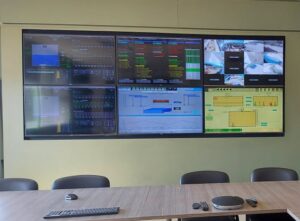
PROJECT RESULTS OF DEYA AIGIALEIA
SUPPLY, INSTAL
LATION, REMOTE-CONTROL AND LEAK DETECTION MONITORING SYSTEM OF THE EXISTING EXTERNAL AND INTERNAL WATER NETWORK OF DEYA AIGIALEIAS.
The remote control and leak detection monitoring system of the existing external and internal water network of DEYA Aigialeias includes:
- 10 local control stations
- 28 internal network stations
- Control center
- Communication center
The goals of the project were to

- Reduce water leaks at least by 50%
- Reduce drilling hours
- Reduse the consumed energy in drilling
- Reduse the network damage and leakage through operating pressure regulation
The internal network has been divided into zones for better and more specialized control. The basic parameters of the zones, are recorded through local pressure and flow recording stations. Some of them have pressure and leakage reducers.
The set of Internal Pressure – Supply Control Network Stations, is depicted on the platform of the following pictures. The user can have a supervisory view of the operating status of the internal network stations, as well as the major malfunction problems that each internal network station presents.



In case the user wishes to see the details and logs of each internal network station in more detail, selects the desired internal network station and is guide
 d to the platforms presented in the next two paragraphs.
d to the platforms presented in the next two paragraphs.
- Internal pressure – flow control stations reducers, are centrally located on the grid and have the ability to automatically limit the grid pressure. Their key features are the pressure recording and automatic adjustment as well as the recording of the supply. These stations are located in central points of the network. The following image illustrates the operating and logging environment of a reducer internal network station.
- The internal control stations reducers of pressure and flow, are located in central points of the network and have the ability to record pressure and flow. The following image illustrates the operation and recording environment of an Internal Network Station. Its basic capabilities are the recording of pressure and flow as well as the detection of water leakage in the ground of the well.
External network stations are located at the network’s production points of storage and distribution. They have the ability to record a wealth of data (pressure, flow, level, quality characteristics etc.) They also enable the remote control of pumps and other equipment. At the same time the statistical data are provided (level, consumption, opening hours etc.) for the set of all installed equipment displaying all active alarms and alerts for each local station. The following images illustrate the external network stations’ operating and logging environment.
LEAK DETECTION SOFTWARE
Leak detection is based on the minimum night consumption and the ratio of maximum to minimum daily consumption. The average nightly water consumption that is internationally accepted per water meter is 3 lt/hour. The ratio of maximum to minimum daily consumption should be at least 4 for zones up to 500-600 water meters. To calculate and detect leaks, the system includes three basic categories, and by them, it can control the distribution of water supplies and water detection indirectly.
The 1st category, includes the balances of the main water tanks, of the central tank and Rena’s  tank. For each of these balances, the system’s inputs and outputs are recorded. Inputs are the values of the supplies of the drillings that feed the tank. Outputs are the values of the supplies from internal network stations fed directly from the tank. In this way the calculation it is possible and, consequently, the detection of leaks in the two balances.
tank. For each of these balances, the system’s inputs and outputs are recorded. Inputs are the values of the supplies of the drillings that feed the tank. Outputs are the values of the supplies from internal network stations fed directly from the tank. In this way the calculation it is possible and, consequently, the detection of leaks in the two balances.
The 2nd category, is consisted of the distribution zones which include drillings with direct supply to consumers. In these zones, drillings supply the tanks that are located in a very short distance and then the tanks supply the consumers directly. Between tanks and consumers, no internal network stations are mediated. Knowing the number of water meters that correspond to each drill, as well as the supply of pumped water, the quality corresponding to each water meter shall be calculated. From this distribution is possible to detect leaks in a particular area.
The 3rd category, is consisted of the distribution zones that include the internal network stations and the total consumer per zone. Knowing the water supply of each zone and the number of water meters corresponding to each zone, the quantity corresponding to each water meter shall be calculated. From this distribution it is possible to detect leaks in the area.

From the recordings before the remote-control system comes into operation, it appears that the leaks in this network are 2.100.000 m3/year. The aim of financing the remote-control system is to reduce leakage to 1.050.000 m3/year.
CALCULATION OF ENERGY AND ECONOMIC PROFIT
For every cubic meter of water, we need energy of 0,68 KWh/0,1€ = (0,68*0,15€/KWh). Saving cubic meters of water, we save electricity, we reduce drilling hours and we have the option to activate the drilling with the most economical operation.
PROJECT RESULTS WITHIN 3 MONTHS OF OPERATION
- Water savings after leak detection for at least 900.000 m3/year.
- Water savings from operating pressure adjustment for at least 45.000 m3/year.
- Saving 600.000 KWh/year.
- Saving 90.000€/year.
Since the remote-control system has been completed very recently, enough data is needed to complete its configuration. In cases of superficial leaks, the detection was immediate, whereas in cases of hidden leaks it took longer to identify the exact point of the leak.
From the analysis of the data so far, other zones where there are leaks have been identified. Deya Aigialeias will detect and repair these leaks in the near future. The volume of water resources saved by the repairs of these leaks is estimated at 400.000 m3/year.








